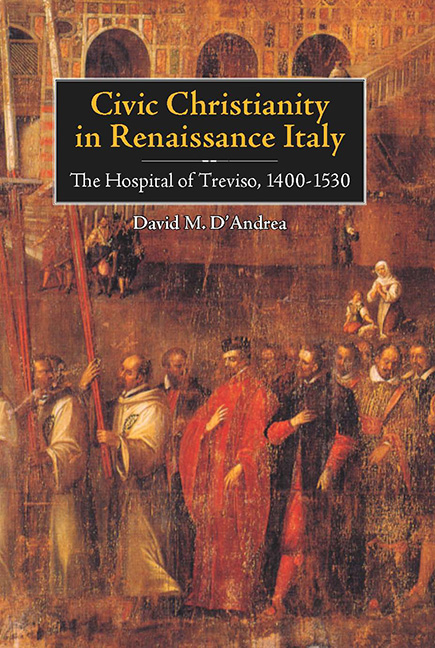Book contents
- Frontmatter
- Contents
- List of Illustrations
- Acknowledgments
- List of Abbreviations
- Notes to the Reader
- Introduction
- Chapter 1 The City of God
- Chapter 2 The Confraternal Family
- Chapter 3 The Bonds and Bounds of Charity
- Chapter 4 Medical Care and Public Health
- Chapter 5 Instruction for This Life and the Next
- Chapter 6 Crisis and Reform
- Notes
- Bibliography
- Index
Chapter 6 - Crisis and Reform
Published online by Cambridge University Press: 08 April 2017
- Frontmatter
- Contents
- List of Illustrations
- Acknowledgments
- List of Abbreviations
- Notes to the Reader
- Introduction
- Chapter 1 The City of God
- Chapter 2 The Confraternal Family
- Chapter 3 The Bonds and Bounds of Charity
- Chapter 4 Medical Care and Public Health
- Chapter 5 Instruction for This Life and the Next
- Chapter 6 Crisis and Reform
- Notes
- Bibliography
- Index
Summary
They say that the two principal and shining lights of our city, Distinguished Fathers and Most Illustrious Citizens, both carry the name of the Glorious Virgin Mary, our Most Sweet Mother and Advocate: one is our hospital, the other is its Monastery and its Sanctuary. With the most absolute certainty we must say and hold firmly that through their merit our city has escaped many dangers and calamities. Yet we can hope for even more if we take care not only to visit, but also to enhance, embellish, and expand these places.
—Podestà Iacopo Morosini's speech to the Grand Council of Treviso approving the restoration of Santa Maria Maggiore (20 March 1474)
In his support of public funding for the restoration of Santa Maria Maggiore, Podestà Morosini made the direct connection between devotion, good works, and divine favor. The Venetian noble reminded the citizens of Treviso that “our” hospital brought honor to the Virgin Mary and therefore protected the city from divine wrath. Morosini's justification reveals that the hospital had become more than one brotherhood's expression of piety. Santa Maria dei Battuti's hospital had been transformed into a symbol of the city that protected the community from disaster. In the early sixteenth century, the relationship between Venice and its subject city would be severely tested by war, famine, and disease. Invading armies would attempt to shake the Trevisan allegiance to Venice, and Venetian authorities would be forced to consider local prerogative versus the needs of the Venetian state. As Morosini's sentiments predicted, during the first decades of the sixteenth century, the hospital would be looked to as a beacon of hope. When rumors of corruption and inefficiency darkened the confraternity's reputation, the communal government exercised its supervisory authority to reform the noble institution and powerful civic symbol.
The beginning of the sixteenth century did not bode well for Venice. Almost all of Europe (France, the Holy Roman empire, Spain, the Papal States, Ferrara, and Mantua) had organized against Venice in the League of Cambrai.1 From 1509 to 1517, mercenaries scorched the land and murdered peasants, plunging Venice into economic and political crisis. A few weeks after the crushing defeat at Agnadello (14 May 1509), foreign troops swept across northern Italy, and the Venetians lost almost their entire mainland state, which had taken a century to construct.
- Type
- Chapter
- Information
- Civic Christianity in Renaissance ItalyThe Hospital of Treviso, 1400–1530, pp. 133 - 148Publisher: Boydell & BrewerPrint publication year: 2007

